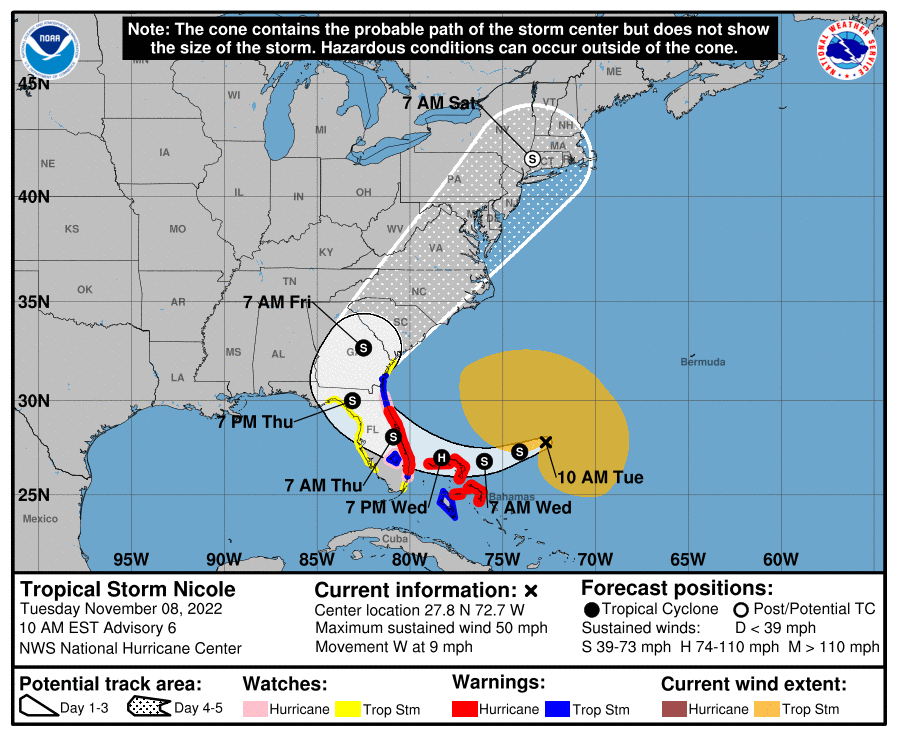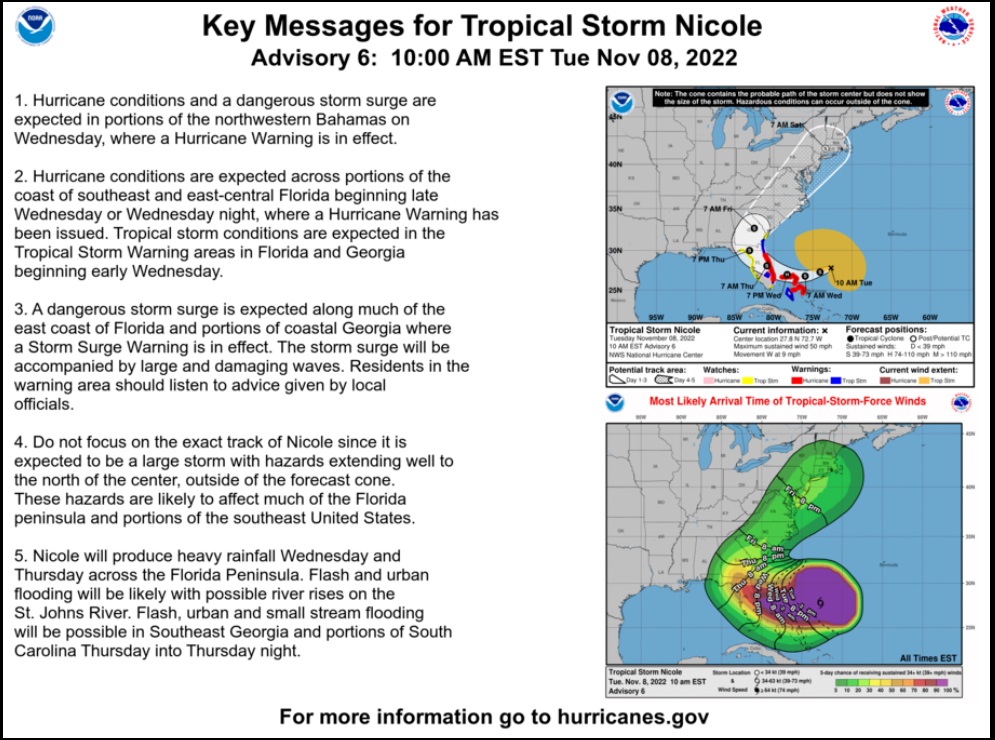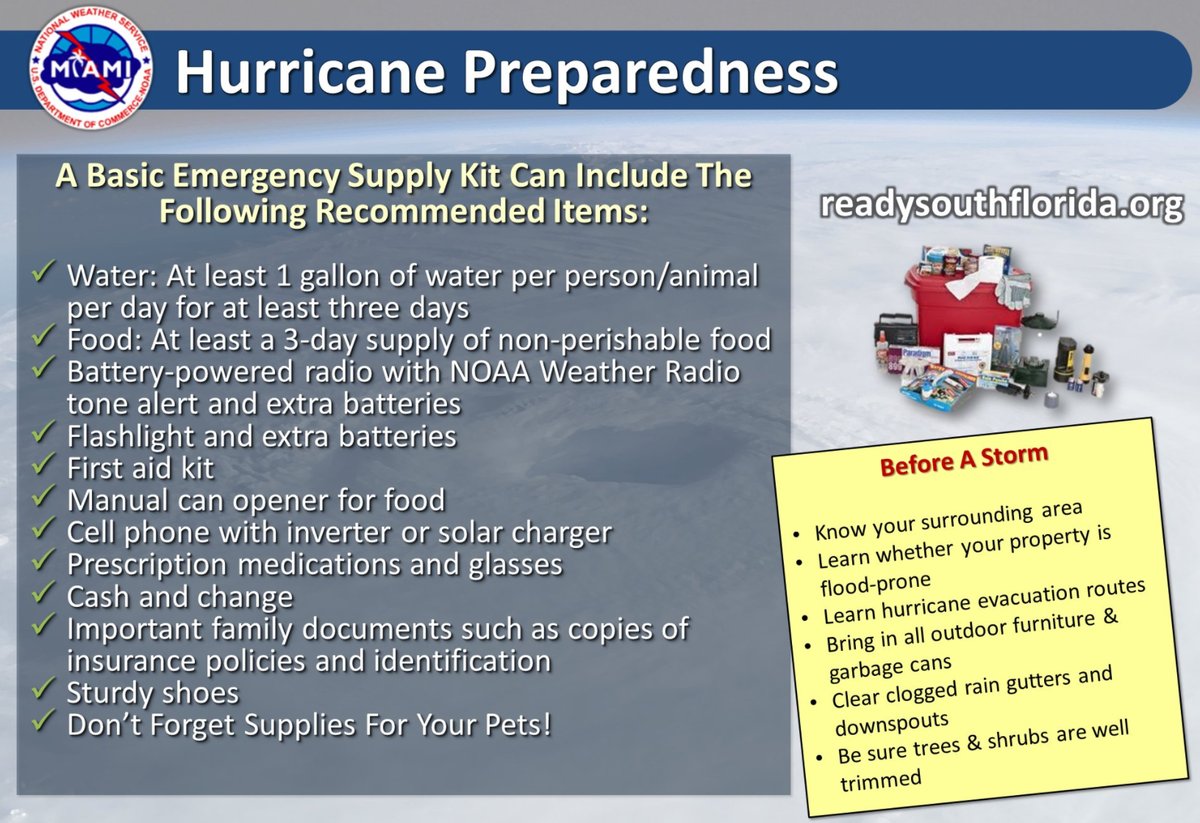The National Hurricane Center is advising Florida east coast residents to prepare for hurricane conditions during the Wednesday overnight hours. [NHC Website] Tropical Storm Nicole is moving quickly toward the Bahamas and will approach the Florida east coast late Wednesday. Florida Governor Ron DeSantis has declared a state of emergency to release resources and trigger support mechanisms.
[NOTE: Florida West Coast – Nicole is a large system with tropical storm force winds extending for 380 miles from center. For SWFL residents in the debris and recovery zone from Ian, the winds from Nicole will be coming from the North, starting soon. Keep this in mind when securing already destabilized structures, roof tarps, fences, debris etc. Anticipate tropical storm force winds arriving from the North tomorrow.]
(NHC) At 1000 AM EST (1500 UTC), the center of Tropical Storm Nicole was located near latitude 27.8 North, longitude 72.7 West. Nicole is moving toward the west near 9 mph (15 km/h). A west to west-southwest motion should continue through Wednesday. A west-northwest motion is forecast to begin on Wednesday night, followed by a turn toward the northwest and north-northwest on Thursday and Thursday night.

On the forecast track, the center of Nicole will approach the northwestern Bahamas today and tonight, move near or over those islands on Wednesday, and approach the east coast of Florida within the hurricane warning area Wednesday night. Nicole’s center is then expected to move across central and northern Florida into southern Georgia Thursday and Thursday night.
Maximum sustained winds are near 50 mph (85 km/h) with higher gusts. Strengthening is expected during the next 36 to 48 hours, and Nicole is forecast to be near or at hurricane strength by Wednesday and Wednesday night while it is moving near the northwestern Bahamas and approaching the east coast of Florida. (more)
The majority of my advice below is for the Florida EAST COAST:

All coastal residents are urged to pay close attention to local officials for evacuation orders. Each locality is different, each coastal locality has a zone of potential flooding and storm surge. As a general rule, hunker down from wind – but evacuate from water.
Today is a good day to organize your important papers, insurance forms, personal papers and place them in one ‘ready-to-go’ location.
Evaluate your personal hurricane and storm supplies; update and replace anything you might have used. Assess, modify and/or update any possible evacuation plans based on your location, and/or any changes to your family status. Fill car with gasoline. Review prescriptions, refill if needed.
Check your shutters and window coverings; test your generator; re-organize and familiarize yourself with all of your supplies and hardware. Check batteries in portable tools; locate tools you might need; walk your property to consider what you may need to do based on the storm’s path. All decisions are yours. You are in control.
Consider travel plans based on roads and traffic density. Being proactive now helps to keep any future stress level low. You are in control. If you have pets, additional plans may be needed.
Do your laundry. Sanitize and stage your water storage. Inventory your supplies. Organize your tools. Fill your freezer with water jugs to take up room and freeze. Test your generator. Stage your extension cords. Stage your battery powered devices. Test your weather radio. Take small steps to prepare. Secure your home. You are in full control.
Hardening your home is a matter of careful thought and physical work. Put 3/4-inch plywood or steel bolted hurricane shutters over all your windows and doors. This is not an option. Every window and door need to be protected, especially glass patio doors (even if tempered). Do not think you can stand there and protect glass doors. It’s beyond dangerous.
You can always tell those people who have been through direct hurricane impacts by how they parked their cars. If you have two vehicles, put one vehicle inside the garage with the front bumper against the door to help stop the flex (do this carefully). Put the other vehicle outside blocking the garage door facing down the driveway or facing parallel to the garage. The goal is to use the aero dynamics of the car to push the wind away from the garage door and provide protection.
Purchase a cheap car cover to protect the outside vehicle and/or use old blankets (cable ties, bungee cords) to stop the outside vehicle from getting sandblasted and destroyed. Place double folded corrugated cardboard in front of the radiator to protect it from storm debris.
[Additionally, if you live in a flood zone, or if you are concerned about storm surge, the day before impact take your #1 car to the nearest airport or hotel with a parking garage and park in the upper levels. Take an uber back home if you don’t have a friend or partner to help you. This way you know you will have one workable vehicle, just in case.]
Beyond the ordinary supplies like drinking water, batteries, flashlights, battery or hand-crank radio, generators, gasoline, etc. Evaluate the scale of what you have against the likelihood of days or weeks without power or water (the timeframe depends on your location to the eyewall of the storm itself). A few pro tips below:
♦ Put three 30-gallon trash cans in the shower and fill them with water before the storm. This will give you 90 gallons of water for cooking and personal hygiene. You will also need water to manually flush your toilets. Bottled water is great for drinking, hydrating and toothbrushing, but you will need much more potable water if the municipal supply is compromised or broken.
♦ A standard 6,500-to-8,500-watt generator will run for approximately 8 hours on five gallons of gasoline. Do not run it all the time. Turn it on, chill the fridge, make coffee, use the microwave or charge stuff, then turn it off. Do this in 4-hour shifts and the fridge will be ok and your gasoline will last longer. Gasoline is a scarce and rare commodity in the aftermath of a hurricane. Gas stations don’t work without power. Check the oil in the generator every few days. Also, have a can of quick start or butane available in case the generator starts acting up.
♦ Extension cords. If you are purchasing them buy at least one 100 to 150′ extension cord with a triple ponytail. This way you can use one cord into a central location to charge up your electronic devices. Establish a central recharging station for phones, pads, laptops, and rechargeable stuff.
♦ Purchase a box of “contractor garbage bags” and just keep them in the garage. These are large, thick, industrial trash bags that fit 40-gallon drums. They can be used for trash, or even cut open for tarps in the aftermath of a storm. These thick mil contractor bags have multiple uses following a hurricane.
♦ Do all of your laundry before the hurricane hits. You will likely not have the ability again for a few days/weeks.
♦ Cook a week’s worth of meals in advance of the hurricane. Store in fridge so you can microwave for a meal. Eating a constant diet of sandwiches gets old after the first week. Dinty Moore canned beef stew and or Chef-boy-ardee raviolis can make a nice break…. anything, except another sandwich.
♦ Have bleach for use in disinfecting stuff before and after a hurricane. Also have antibiotics and antiseptics for use. Hygiene and not getting simple infections after a hurricane is critical and often forgotten. Again, this is where the extra potable water becomes important. Simple cuts and scrapes become big deals when clean potable water is not regularly available. Keep your scrapes and abrasions clean and use antiseptic creams immediately.
♦ Do not forget sunscreen and things to relieve muscle aches and pains. Hurricane recovery involves physical effort. You will be sore and/or exposed to the elements. Remember, it’s all about self-sufficiency because the normal services are not available. A well-equipped first aid kit is a must have.
♦ Buy a small camping stove. Nothing big or expensive, just something you can cook on outside in case of emergency. It will be a luxury when you are 2+ weeks without power and all the stores and restaurants are closed for miles.
♦ Those small flashlights that you can strap around your head that take a few AAA batteries? Yup, GOLD. Those types of handsfree flashlights are lifesavers inside and outside when you need to see your way around. Nighttime is especially dark without electricity in the entire town. Doing stuff like filling a generator with gasoline in the middle of the night is much easier with one of those head strap flashlights. Strongly advise getting a few, they’re inexpensive too.
♦ Cash. You will need it. Without power anything you may need to purchase will require cash, especially gasoline. Additionally, anyone you hire to help or support your immediate efforts will need to be paid. Cash is critical. How much, depends on your individual situation, but your cash burn rate will likely go into the thousands in the first few days. Also keep in mind, you may or may not be able to work and without internet access even getting funds into place, or paying bills electronically, could be challenging.
♦ Hardware. A box of self-tapping sheet metal screws (short and long) is important, along with a box or two of various wood screws or Tyvex screws. A battery drill or screw gun is another necessity. Check all of this stuff during hurricane prep.
Keep a positive outlook at all times. Do not fall into the trap of mental exhaustion, frustration and crisis. Write down your plans and then check them off so you can reward your brain with the sense of accomplishment. Trust me, this works. Keep a stable and optimistic disposition. Be flexible and charitable toward everyone.
Do not be alarmed – but take every preventative measure your individual situation needs. Work your hurricane plan and stay focused on what you do control. Proactive planning prevents stress. Work the plan, step by step and focus only on what is in front of you. Ignore the dark imaginings and turn off the national media. Pay attention to your local officials and local media.
Above all, pray. Be kind, retain a servant’s heart, be strong and deliberate while remaining focused as a good steward for your family, friends and community.
It might suck for a while, but it will be okay.

Well, at least we got to vote over here in Melbourne. = ) Fortunately, we only had to put up 3 shutters (the rest were already up) and are still very well stocked and prepared from Ian. Time to help the neighbors!
I was living in Melbourne in 1979 when Hurricane David blew through. In a cheap rental house with awning-type crank out windows! Had to duct tape them shut to prevent leakage.
Prayers for your safety!
Floridian pro-tip: those are called Jalousie windows!
Kudos for helping those less prepared. Stay safe!
We early voted last week in person in Melbourne, went camping at Silver Springs. Shortened trip; came home today because of Nicole 🤷🏼♂️
I have posted several times that these storms are being produced/steered. Also said that “they” would hammer DeSantis/Florida. They missed the timing ….people will still go out and vote.
HAARP
GeoEngineeringWatch.org
This is terrible.
Praying.
8 years during Obama – no hurricanes.
Hurricane Sandy came ashore in northern New Jersey Oct. 29, 2012.
I have absolutely zero respect for the former Community Terrorizer-in-Chief but, your post is not true.
Sandy wasn’t a hurricane. It was a superstorm due to the storm surge, but was not hurricane force winds.
Too bad he’s so selfish he would only stop them when he was President. I bet his two beachfront Mansions will be fine.
Good luck. Stay safe and be careful. A Canadian acquaintance just drove his RV down there for the winter and arrived yesterday. Hardly the best timing!
Two things I would add that I suggested when Ian stuck.
A brick rocket stove is simple to make and it uses wood scraps or sticks for fuel >
and you can boil water, heat food, etc.
A camping bag shower. Fill with water, place it in a sunny place to warm up and carry it inside to use it in privacy > https://www.walmart.com/ip/Ozark-Trail-Camp-Shower-5-Gallon-Solar-Shower/ but remember water weighs more than 8 pounds per gallon so you will need a sturdy hook to hold it when it is full.
Works well in the cold. I’ll stick with a propane camping stove set up on top of my range, inside, out of the residual rain squalls following the ‘caines and heat/humidity and mosquitoes that always blow in in huge numbers.
Cool! I save my drier lint and make balls coated with Vaseline for starters…
The dryer sheets are slap full of petroleum products. The dryer lint goes up quick with a decent magnesium striker. Great idea adding vaseline to the mix.
I used to send those to Iraq all the time.
Solar showers rock. I have been to hunting leases in Florida that have/had 35 or 55 gallon plastic barrels painted black (originally blue)with PVC plumbing and a showerhead. The barrel was on a platform with a shower stall underneath. Nearby creeks provided the water.
Thanks for your very wise advice again!
On this election day, as we wait upon what the Lord has in store for our country, I pray the Giver of all good gifts protects, comforts, strengthens, and assures all His children that He controls the storm and is in the storm with them.
With us.
In every storm.
Through Jesus Christ, The Lord.
I didn’t see any advice to move your EV away from the Hurricane path now!
Also, interesting how in an emergency suddenly gasoline is the savior because it will run a generator.
Back in Florida after an October sojourn thru CO, NV and OR – sitting on the causeway here on the Indian River and the wind is steady NE at 20+, or a Beaufort Force 5, for the nautical thinkers amongst us here today.
Very windy here. Just been out and tied all my tomatoes and peppers more securely! North FL
Just looked out my office window here in Tallahassee, FL. No wind…yet. It is cloudy, though. Praying for a rain event up here D2 soils are DRY.
My veggies are sick of the groundwater.
Nicole is going right up the East Coast…hmmm.
Sundance, your last line is giving me some much needed peace of mind. Thank you!
I have fanaticized about relocating to Florida in my retirement years but I couldn’t deal with constant threats of tropical storms and hurricanes. Plus, too many weird bugs and alligators! other than that, I’m sure Florida has much to offer.
I am beyond upset. My debris pickup was scheduled for the end of this week. Now it is a major danger for projectiles that I do not have the capacity to mitigate. Can’t find help.
Given the political climate, I read “TransSexual Nicole likely to become…” I was like “good grief, now they identify as WEATHER!”
Keep posted at windy.com…
Change is a given.
Well I guess I will lose electricity again for three days, heading out to vote.
I really am beginning to believe the weather manipulators tin-foil hat theory.
it appears ((they)) won’t stop until they level Mar-a-Lago…
That would take out Nan’s retirement Palace..
Now NASA has to put another rubber round trip on the $$Bazillion Boondoggle and roll it right back into shelter. It’s that big storm that the red-head on the beach has been warning us about…
Is this happening because DeSantis refused federal election watchers in Florida?
Mar-a-Lago looks to sit close to the center of the probability cone. The storm is coming? Prayers the real President’s residence stands as resolute and unmoved as the real President did during the storm at his Miami rally this past Sunday!
Oh dear. Y’all have had enough.
Praying.
Sundance – You are “The Man”! I’m a flyover landlubber and I will use and adjust, as necessary, your preparedness list. We don’t get large hurricanes, but we do get tornados. Since you’ve lived it all there with Ian, your advice is well-received and applicable most everywhere. Thank you and GOD BLESS YOU!
Here is the 4:00 pm update:
https://www.nhc.noaa.gov/graphics_at2.shtml?start#contents
max winds 65 mph, moving west at 10 mph….990 mb pressure.
Reminds me of Andrew, that overnight shot up to cat 4